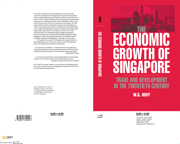Book contents
- Frontmatter
- Contents
- List of figures
- List of tables
- Preface and acknowledgements
- Abbreviations and conventions
- Geographical definitions
- Introduction
- Part One Themes and beginnings
- Part Two Development as a staple port, 1900–1939
- Part Three Staple port and rapid growth, 1947–1990
- 10 The staple port resurgent: development to 1959
- 11 Markets, government and growth, 1960–1990
- 12 Conclusion
- Appendix tables
- Bibliography
- Index
11 - Markets, government and growth, 1960–1990
Published online by Cambridge University Press: 22 September 2009
- Frontmatter
- Contents
- List of figures
- List of tables
- Preface and acknowledgements
- Abbreviations and conventions
- Geographical definitions
- Introduction
- Part One Themes and beginnings
- Part Two Development as a staple port, 1900–1939
- Part Three Staple port and rapid growth, 1947–1990
- 10 The staple port resurgent: development to 1959
- 11 Markets, government and growth, 1960–1990
- 12 Conclusion
- Appendix tables
- Bibliography
- Index
Summary
Between 1960 and 1990 Singapore grew rapidly, and for almost all this period trade was again the engine of growth. But three changes set these decades apart from earlier twentieth-century development. First, economic development ceased to depend on staples as the economy diversified, initially through manufactures and then through financial and business services. By 1970 manufacturing had made sufficient impact on the economy to be regarded as a leading sector. Three years later, manufacturing ended the labour surplus condition, and with it the dual economy, analysed in earlier chapters, so that 1973 may be dated as a turning point in economic development.
The second change was that growth stemmed from a new set of entrepreneurs in the form of public (i.e. government) enterprises and, even more, multinational enterprises (MNEs). By 1990 agency houses, so fundamental to Singapore's pre-World War II economic development, had, with a few exceptions, disappeared; local Chinese entrepreneurs, although still found especially in primary commodity exports, took a back seat. Third, an activist government committed to development guided economic transformation. Planning, begun with the report of a United Nations team in 1961, lay behind Singapore's growth.
After 1960 the look of Singapore altered fundamentally from a still largely coastal city made up of shophouses and fringed by squatter dwellings to an island-wide settlement of satellite new towns (19 by the 1990s), built as high-rise public housing.
- Type
- Chapter
- Information
- The Economic Growth of SingaporeTrade and Development in the Twentieth Century, pp. 299 - 360Publisher: Cambridge University PressPrint publication year: 1994



